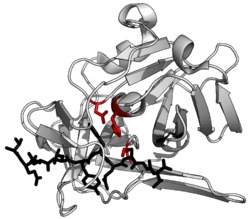Protease
A protease is a digestive enzyme. It breaks down long chains of proteins into shorter amino acids. Proteases have evolved a number of times. We know this because different kinds of protease can do the same reaction in completely different ways. Proteases are found in animals, plants, bacteria, archaea and viruses.
Now more than 50 types of protease are known. Each is a separate evolutionary origin of proteolysis.[1][2]
Protease can be divided into 6 types :
- serine proteases
- threonine proteases
- cysteine proteases
- aspartate proteases
- metallo proteases
- glutamic acid proteases
Protease Media
Ribbon diagram of a protease (TEV protease) complexed with its peptide substrate in black with catalytic residues in red.(PDB 1LVB)
References
- ↑ Rawlings N.D; Barrett A.J. & Bateman A. 2010 (2010). "MEROPS: the peptidase database". Nucleic Acids Research. 38 (Database issue): D227–33. doi:10.1093/nar/gkp971. PMC 2808883. PMID 19892822.
{{cite journal}}: CS1 maint: multiple names: authors list (link) - ↑ MEROPS, the peptide database. [1] Archived 2006-11-14 at the Wayback Machine
